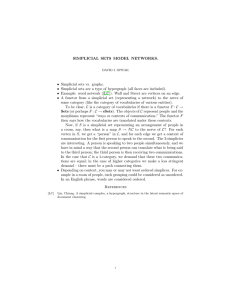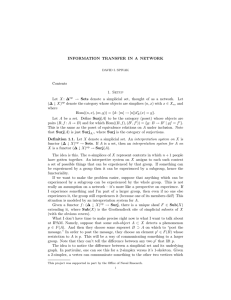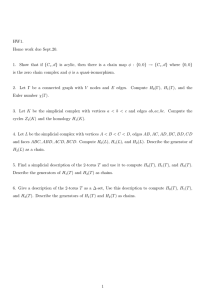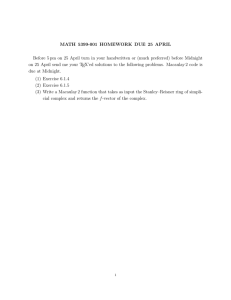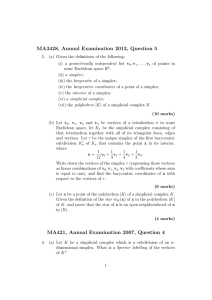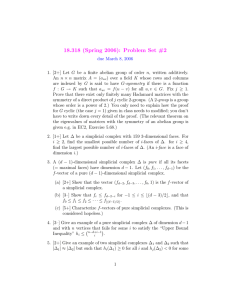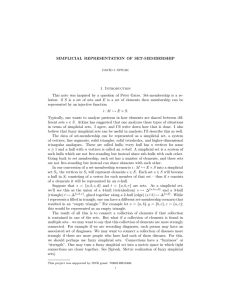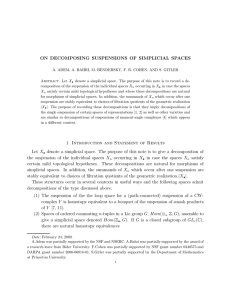SIMPLICIAL DATABASE AGGREGATION 1. Introduction
advertisement
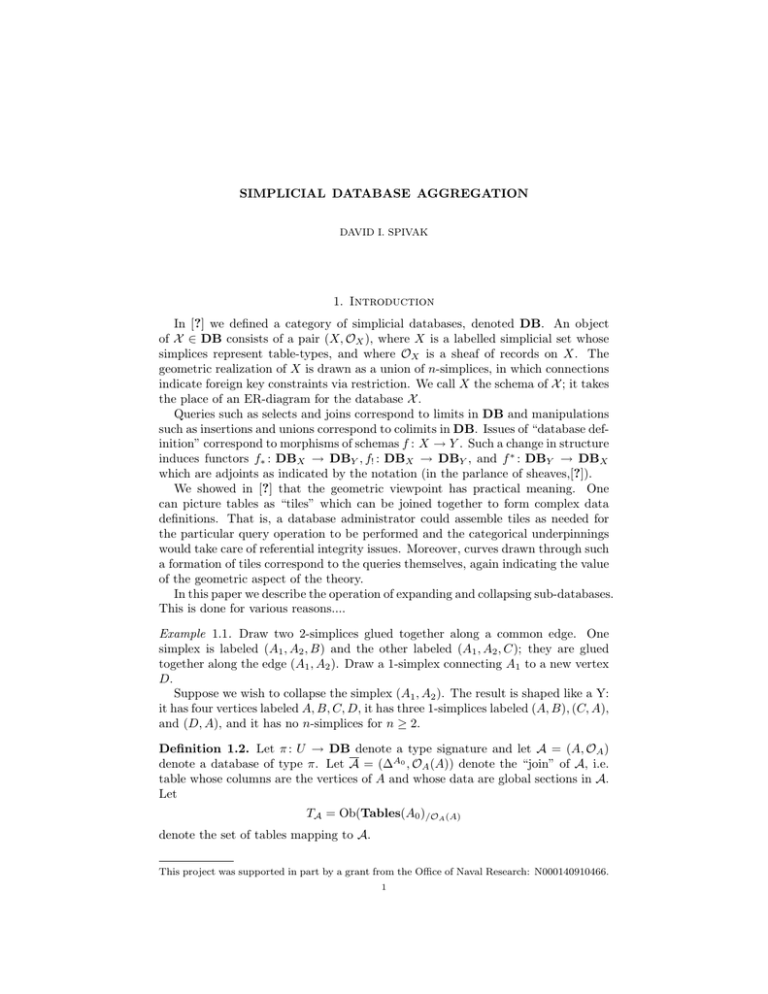
SIMPLICIAL DATABASE AGGREGATION
DAVID I. SPIVAK
1. Introduction
In [?] we defined a category of simplicial databases, denoted DB. An object
of X ∈ DB consists of a pair (X, OX ), where X is a labelled simplicial set whose
simplices represent table-types, and where OX is a sheaf of records on X. The
geometric realization of X is drawn as a union of n-simplices, in which connections
indicate foreign key constraints via restriction. We call X the schema of X ; it takes
the place of an ER-diagram for the database X .
Queries such as selects and joins correspond to limits in DB and manipulations
such as insertions and unions correspond to colimits in DB. Issues of “database definition” correspond to morphisms of schemas f : X → Y . Such a change in structure
induces functors f∗ : DBX → DBY , f! : DBX → DBY , and f ∗ : DBY → DBX
which are adjoints as indicated by the notation (in the parlance of sheaves,[?]).
We showed in [?] that the geometric viewpoint has practical meaning. One
can picture tables as “tiles” which can be joined together to form complex data
definitions. That is, a database administrator could assemble tiles as needed for
the particular query operation to be performed and the categorical underpinnings
would take care of referential integrity issues. Moreover, curves drawn through such
a formation of tiles correspond to the queries themselves, again indicating the value
of the geometric aspect of the theory.
In this paper we describe the operation of expanding and collapsing sub-databases.
This is done for various reasons....
Example 1.1. Draw two 2-simplices glued together along a common edge. One
simplex is labeled (A1 , A2 , B) and the other labeled (A1 , A2 , C); they are glued
together along the edge (A1 , A2 ). Draw a 1-simplex connecting A1 to a new vertex
D.
Suppose we wish to collapse the simplex (A1 , A2 ). The result is shaped like a Y:
it has four vertices labeled A, B, C, D, it has three 1-simplices labeled (A, B), (C, A),
and (D, A), and it has no n-simplices for n ≥ 2.
Definition 1.2. Let π : U → DB denote a type signature and let A = (A, OA )
denote a database of type π. Let A = (∆A0 , OA (A)) denote the “join” of A, i.e.
table whose columns are the vertices of A and whose data are global sections in A.
Let
TA = Ob(Tables(A0 )/OA (A)
denote the set of tables mapping to A.
This project was supported in part by a grant from the Office of Naval Research: N000140910466.
1
2
DAVID I. SPIVAK
We define the addition of A to π, denoted π ⊕ A to be the function
U q TA
DT q {‘TA ‘}.
0
We denote the 0-simplex ∆{‘TA ‘} by ♦ ∈ Ob(Schπ ).
At present, we have a working construction only in the case that the schema X
is a “simplicial complex” as in Definition 1.3. While the work in [?] is much more
general, most databases that currently exist are modeled on a simplicial complex.
Roughly that means that no two tables can have the same set of attributes (though
they can have the same set of datatypes).
In the definition below, we write P(V ) to denote the power-set of a set V , and
for elements s, t ∈ P(V ) we write t ≤ s to mean that t ⊂ s ⊂ V . Given a function
f : V → V 0 and subset s ⊂ V , we write f! (s) to denote its image in V 0 .
Definition 1.3. A simplicial complex over DT consists of a pair (V, S) where V
is a set over DT and S ⊂ P(V ) is a set of subsets of V such that if s ∈ S and t ≤ s
then t ∈ S. Note that S is in fact a poset.
A morphism of simplicial complexes over DT f : (V, S) → (V 0 , S 0 ) is a function
f : V → V 0 over DT such that f! (s) ∈ S 0 for all s ∈ S.
An attribute-defined simplicial database is a simplicial database (X, K, τ ) such
that X = (V, S) is a simplicial complex over DT. In other words K is a functor
S op → Sets and τ : K → UX is a natural transformation, defined as in [?].
Suppose that A ⊂ V is a subset; we write V /A to denote the pushout of the
diagram V ← A → {♦}, and we write q : V → V /A to denote the quotient map,
which is isomorphic on V − A and sends all of A to ♦.
Definition 1.4. Let X = (V, S) be a simplicial complex and let A ⊂ V be a set of
vertices. Let X/A = (W, T ) where W = X/A and T = {f! (s)|s ∈ S}.
If X is a simplicial complex over DT, and A ⊂ V
